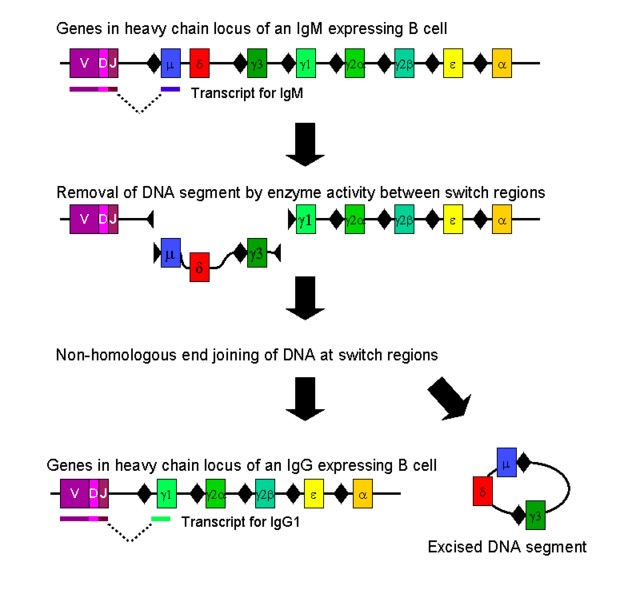Playlist
Show Playlist
Hide Playlist
Mediation of Antigen Receptor Genetic Recombination – Lymphocyte Development
-
Slides Adaptive Immune System.pdf
-
Reference List Immune System.pdf
-
Download Lecture Overview
00:01 Let’s take a few moments to look in a little bit more detail at how this genetic recombination process actually is mediated. 00:11 Really depends on two things, or requires two things. 00:15 Requires a number of different enzymes that catalyze the recombination process, but it also requires recognition sequences for these enzymes, in other words substrates for these enzymes that are within the DNA sequence. 00:30 Okay? They’re not in the part of the DNA that encodes the protein but they lie immediately adjacent to that part. 00:39 And they’re called Recombination Signal Sequences or RSS. 00:46 And the enzymes that recognize these Recombination Signal Sequences, their nucleotide sequences as I say, flanking the V, D and J segments; the enzymes that recognize, or the two most important enzymes that recognize these Recombination Signal Sequences are called RAG-1 and RAG-2. 01:04 So heavy chain VDJ recombination, and likewise light chain VJ recombination is mediated by the recombinase enzymes RAG-1 and RAG-2; stands for Recombination Activating Genes, even though they’re actually proteins that come from those genes. 01:23 And they recognize these Recombination Signal Sequences or RSS, which are nucleotides flanking the V, D and J gene segments. 01:32 And as you can see from this particular picture, the V segment has an RSS immediately three prime or downstream of the protein coding sequence. 01:44 The D segment has two RSSs, one either side. 01:48 And the J segment has a signal RSS five prime or immediately upstream of its sequence. 01:55 So following successful heavy chain recombination of VDJ, the light chain is then recombined, because an antibody needs both a heavy chain and a light chain. 02:06 And here we can see the Variable region of the kappa (k) light chain, around about 40 different Variable segments for the light chain in the k… for the k light chain. 02:17 And five or so Joining gene segments. 02:21 And this particular B-cell has decided to recombine its k light chain using a Vk2 and recombining it next to Jk2. 02:35 And then just as we saw for the heavy chain, it will make a primary RNA transcript, it will process that into message and then translate that into protein. 02:43 And again the CDR3 in the light chain is the most variable because it’s a combination of any one out of those 40 Vs, put next to one of those five different J gene segments. 02:56 So the recombination occurs in both the heavy chain and the light chain, and that recombination being a fairly random process is not actually always successful. 03:09 Sometimes it doesn’t work. 03:11 So there might be a out of reading frame sequence generated or maybe a stop codon is generated. 03:18 So in some ways, it’s a bit of a wasteful process given that it doesn’t always work. 03:22 But it’s an incredibly powerful process because it means that from a handful of genes, you can make millions, and millions, and millions and millions of different antibody molecules; and likewise many, many million different T-cell receptor molecules. 03:40 So the sequence of events is that there are two attempts at recombining the heavy chain. 03:45 Remember we have two copies of each chromosome. 03:47 So you’ve inherited one copy of your immunoglobulin heavy chain genes from your mom and another copy from your dad. 03:54 And given that this random process is not always successful, maybe you fail to make a B-cell, fails to make a productive, what we call productive recombination on one of the chromosomes. 04:06 All’s not lost, it can try the other chromosome. 04:09 As long as one attempt is successful, then it will go on, the B-cell will go on and recombine the light chain genes. 04:18 It starts off with the k light chain. 04:21 Again there are two attempts, because you have two versions. 04:24 One you’ve inherited from your mom, one from your dad. 04:27 In fact, for the light chains, there’s a total of four possible attempts, because as well as having the k light chain genes as we’ve already heard, we have the lambda (λ) light chain genes. 04:38 So if both recombinations on the k chain are unsuccessful, there’s still hope left, there’s still a chance, because there are two λ chain gene loci. 04:48 So hopefully the B-cell will be successful in both the heavy chain recombination, one out of two choices, light chain recombination, one out of four choices. 05:00 And produce a functional antibody molecule that will then be put on the cell surface. 05:06 It's important that B-cells are specific for one single antigen. 05:13 So for example, you’ll have one B-cell that’s specific for Staphylococcus, another for Streptococcus, another for Candida, another for Cytomegalovirus and so on. 05:22 And in order to ensure that the B-cell is only specific for a single antigen, you need to just have one heavy chain sequence and one light chain sequence. 05:36 And that is ensured by a process that is referred to as allelic exclusion. 05:42 The result of allelic exclusion is that if the first attempt at recombining a heavy chain is successful, recombination on the other chain is prevented. 05:54 It’s not allowed. 05:55 So as the first recombination is successful, you make a protein, there’s feedback mechanism that prevents recombination on the other heavy chain locus. 06:06 Likewise, for the light chain recombination, if there’s a successful recombination of the light chain, either the k light chain or the λ light chain, it prevents subsequent recombination of other light chain loci. 06:19 So, allelic exclusion ensures that there isn’t a mixture of different heavy chains or different light chains for a given B-cell; just one heavy chain, one light chain. 06:29 There’ll be millions of copies, but they’ll all be identical.
About the Lecture
The lecture Mediation of Antigen Receptor Genetic Recombination – Lymphocyte Development by Peter Delves, PhD is from the course Adaptive Immune System. It contains the following chapters:
- Mediation of the Genetic Recombination
- Genetic Recombination of the Heavy Chain
Included Quiz Questions
During V(D)J recombination in immature B cells, recombination signal sequences are recognized by which of the following?
- Recombination-activating gene 1/Recombination-activating gene 2 enzymes
- Diversity regions
- Leading regions
- Constant regions
- Joining regions
Which of the following is NOT true regarding Recombination-activating gene 1/Recombination-activating gene 2 enzymes?
- They translate recombination signal sequences.
- They mediate recombination of immunoglobulin genes.
- They mediate both heavy and light chain recombination.
- They recognize recombination signal sequence (RSS) nucleotides.
- They regulate the expression of the V, D, and J segments.
Genetic recombination of the immunoglobulin heavy and light chains occur in a specific sequence. Which of the following most accurately reflects that sequence?
- Recombination of the VDJ segments of the heavy chains followed by the VJ segments of the light chains
- Recombination of the VJ segments of the heavy chains followed by the VDJ segments of the light chains
- Recombination of the VDJ segments of the light chains followed by the VJ segments of the heavy chains
- Recombination of the VDJ segments of the light chains followed by the VDJ segments of the heavy chains
- Recombination of the VJ segments of the light chains followed by the VJ segments of the heavy chains
Which of the following combinations of light and/or heavy chains typically constitutes a complete antibody?
- 2 heavy chains and 2 light chains
- 2 heavy chains or 2 light chains
- 1 heavy chain and 1 light chain
- 1 heavy chain and 2 light chains
- Any combination is possible.
Customer reviews
5,0 of 5 stars
| 5 Stars |
|
5 |
| 4 Stars |
|
0 |
| 3 Stars |
|
0 |
| 2 Stars |
|
0 |
| 1 Star |
|
0 |




